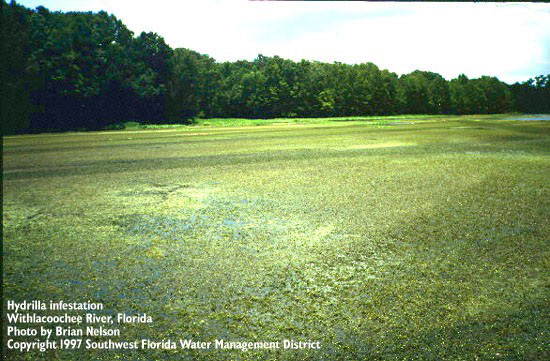Issue 7, June 5, 2009
Invasive Species Spotlight--Hydrilla
Last week, our invasive species spotlight focused on Brazilian elodea. Like this last aquatic invader, hydrilla is an aggressive invasive plant that can rapidly displace native aquatic vegetation. In fact, hydrilla and Brazilian elodea are similar in many ways. These non-native plants form thick mats under water that shade out native vegetation, block the flow of water, and impede fishing and recreational activities, among other things.
Hydrilla can be difficult to identify as it closely resembles both Brazilian elodea and American elodea (also known as American water-weed). These plants can be separated by the presence of tubers. Both Brazilian elodea and waterweed lack the yellowish, pea-like structures that are buried in the sediment. Hydrilla has leaves in whorls around the stem (generally 5 leaves per whorl), along the leaf edges are serrations or small spines, and the leaf midrib is often reddish when fresh. It can survive in a few inches of water or in water as deep as 20 feet.

Hydrilla can reproduce by several different methods. While seeds play a very small role in the reproductive process, it still has excellent survival and dispersal strategies. Hydrilla breaks apart very easily. In fact, it spreads to new waters mainly as fragments on boats and trailers. These small pieces of stem can produce entire new plants. Hydrilla possesses special structures called turions (on the stems) and tubers (in the sediment). The turions break off of stems and can float long distances before sinking to start a new plant. And the tubers that help identify this invasive plant, can also lead to the production of several hundred others in the course of one growing season! These tubers create a huge challenge when attempting eradication as they can lay dormant in the sediment for several years, even if no water is present.

Click for a great resource for hydrilla, including comparison photos of Brazilian elodea and waterweed.
Visit the Illinois CAPS website for all the latest news on invasive pests in Illinois.--Kelly Estes
Author:
Kelly Estes